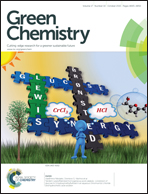From lignocellulosic biomass to renewable cycloalkanes for jet fuels†
Abstract
A novel pathway was investigated to produce jet fuel range cycloalkanes from intact biomass. The consecutive processes for converting lignocellulosic biomass into jet fuel range cycloalkanes principally involved the use of the well-promoted ZSM-5 in the process of catalytic microwave-induced pyrolysis and RANEY® nickel catalysts in the hydrogen saving process. Up to 24.68% carbon yield of the desired C8–C16 aromatics was achieved by catalytic microwave pyrolysis at 500 °C. We observed that solvents could assist in the hydrogenation reaction of naphthalene; and the optimum result for maximizing the carbon selectivity (99.9%) of decalin was obtained from the reaction conducted in the n-heptane medium. The recovery of organics could reach ∼94 wt% after the extraction process. These aromatics in the n-heptane medium were eventually hydrogenated into jet fuel range cycloalkanes. Various factors were analyzed to determine the optimal result under mild conditions. An increased catalyst loading, reaction temperature, and prolonged time could enhance the hydrogenation reactions to improve the selectivity of jet fuel range cycloalkanes. Three types of hydrogenation catalysts (NP Ni, RANEY® Ni 4200, home-made RANEY® Ni) were chosen to evaluate the catalytic performance. The results indicated that the home-made RANEY® nickel is the optimal catalyst to obtain the highest selectivity (84.59%) towards jet fuel range cycloalkanes. These cycloalkanes obtained can be directly used as additives to synthesize the desired jet fuels by blending with other hydrocarbons. Hence integration of catalytic processes and conversion of lignocellulosic biomass paved a new avenue for the development of green bio-jet fuels over inexpensive catalysts under mild conditions.


 Please wait while we load your content...
Please wait while we load your content...